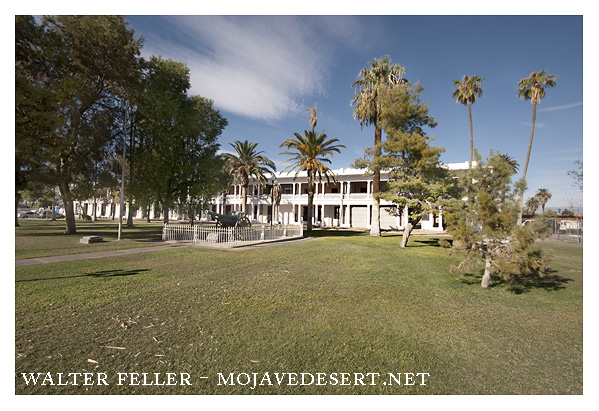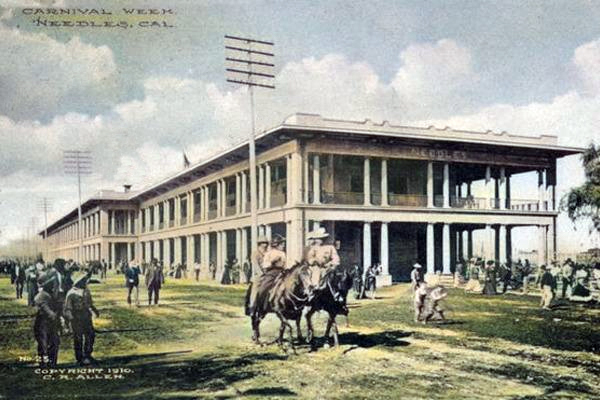El Garces

El Garces Harvey House History, Needles, California
The El Garces Harvey House in Needles, California, has a rich history tied to the development of the American Southwest and the Santa Fe Railway. Here is a detailed overview of its history:
Early History and Construction

El Garces - 1910
Origins:
The El Garces Harvey House was part of the Fred Harvey Company's chain of hotels, restaurants, and hospitality services designed to serve passengers on the Atchison, Topeka and Santa Fe Railway (Santa Fe Railway). Named after Father Francisco Garces, an 18th-century Franciscan missionary and explorer, El Garces was envisioned as a luxury stop for travelers.Construction:
The construction of El Garces began in 1906 and was completed in 1908. The building was designed in the Mission Revival style, which was popular at the time and reflective of California's Spanish colonial heritage. The architectural firm of Francis W. Wilson & William J. Dodd was responsible for its design.Operations
Harvey House:
As a Harvey House, El Garces offered a full range of amenities for travelers, including dining facilities, comfortable lodging, and impeccable service provided by the famous Harvey Girls. These young women were recruited from the East and Midwest and were known for their professionalism and hospitality.Role in Rail Travel:
El Garces played a significant role in the heyday of rail travel, serving passengers on the Santa Fe Railway's major routes. It was a bustling hub of activity, providing rest and respite in the harsh desert environment of Needles.Decline and Closure
Changes in Travel:
With the advent of the automobile and the decline in passenger rail travel after World War II, many Harvey Houses, including El Garces, saw a decrease in business. The rise of highways and the growth of commercial aviation further reduced the need for such facilities.Closure:
El Garces ceased operations as a Harvey House in 1949. After its closure, the building was used for various purposes but eventually fell into disrepair.Restoration and Preservation
Restoration Efforts:
Recognizing the historical and architectural significance of El Garces, efforts to preserve and restore the building began in the late 20th century. Various community groups and preservationists worked tirelessly to save the structure from demolition.Current Status:
Today, El Garces has been partially restored and serves as a symbol of Needles' rich history and its connection to the golden age of rail travel. The building is listed on the National Register of Historic Places and continues to be a point of interest for visitors and historians alike.Legacy
Cultural Impact:
El Garces stands as a testament to the era of the Fred Harvey Company and the Santa Fe Railway's influence on the development of the American Southwest. It represents a bygone era of luxury and service that played a crucial role in making long-distance rail travel comfortable and enjoyable.Community Significance:
For the community of Needles, El Garces is more than just a historical building; it is a cherished landmark that encapsulates the town's heritage and its role in the broader narrative of American transportation history. The El Garces Harvey House remains an important piece of the cultural and architectural tapestry of the American Southwest, symbolizing the intersection of travel, hospitality, and history.

The Harvey Girls
Early in the 1900s, when trains were the principal means of personal transportation, depots gave travelers a first impression of their local destinations and provided for the security and comfort of the railroad's clientele. Design and materials were important to both surrounding communities and railroad companies. After the Atchison, Topeka, and Santa Fe Depot at Needles burned in 1906, the railroad spared no expense on its new facility. Built to suggest a Greek temple and opened in 1908 to great adulation, Garces was a freight and passenger depot with hotel and restaurant amenities. The depot took its name from missionary Father Francisco Garces, known as the first European to cross the Mojave Desert.The depot was luxurious. Large Mexican Fan Palms native to the site surrounded the two-story building with its distinctive symmetrical facade. Architect Francis S. Wilson included interior open-air loggias upstairs and down. Tuscan columns placed in pairs supported these walkways. The interior ceilings were ornamental and intricate egg-and-dart detailing edged the woodwork. Wilson's use of the Classical Revival style, particularly popular on the East Coast and for civic and residential buildings, was unusual for a western depot and lent an aura of sophistication to the small town.
One reason for the success of Garces was its beauty. Another was its management by the Fred Harvey Company. Known as "the civilizer of the West," Fred Harvey managed a large line of cafes and hotels along the Atcheson, Topeka, and Santa Fe Railroad. Motorists also availed themselves of Harvey establishments, including Garces, after the construction and marking of the National Old Trails Highway during the 1910s. This highway often ran parallel to the railroad, providing a continuous automobile route between St. Louis and Los Angeles.
Whether traveling on the Atcheson, Topeka, and Santa Fe Railroad or along the National Old Trails Highway or, later, Route 66, patrons appreciated the quality of service that Harvey establishments provided. A Harvey-run restaurant or hotel often had the nicest dining facilities and friendliest service in town. Garces was known for linen and silver, distinctive china, and fresh flowers that it provided daily for guests. The lunchroom had two horseshoe-shaped counters and could serve 140 people. According to the Harvey Girls, who traveled the country to work for the company, Garces was a crown jewel in the enterprise. An assignment to the Grand Canyon, to Las Vegas, or to Garces was "like going to Europe." Community members also used the facilities for private dinners, banquets, and special occasions.
Though motorists and railroad passengers alike made Garces a popular destination through the end of World War II, the waning popularity of railroad passenger service in favor of automobile travel took a toll on Harvey Houses. Automobile travel was accessible to people with a wider range of incomes, who often could afford to travel but not to dine or stay at a place as opulent as Garces. Garces closed as a Harvey House in the fall of 1949, at which time the building was partitioned and used as Santa Fe Railway offices. In 1988, the Santa Fe Railroad moved to another facility and closed the building. Abandoned, Garces was under threat of destruction until a local group formed in 1993 as the Friends of Garces. The group petitioned the City of Needles to purchase the station, an effort that succeeded in 1999. The National Park Service recognized the building's significance in 2002, by listing it in the National Register of Historic Places. Though still renovating the facility, the city plans to reopen it as a "Harvey House Hotel," including a Route 66 museum and shops.
Source - NPS